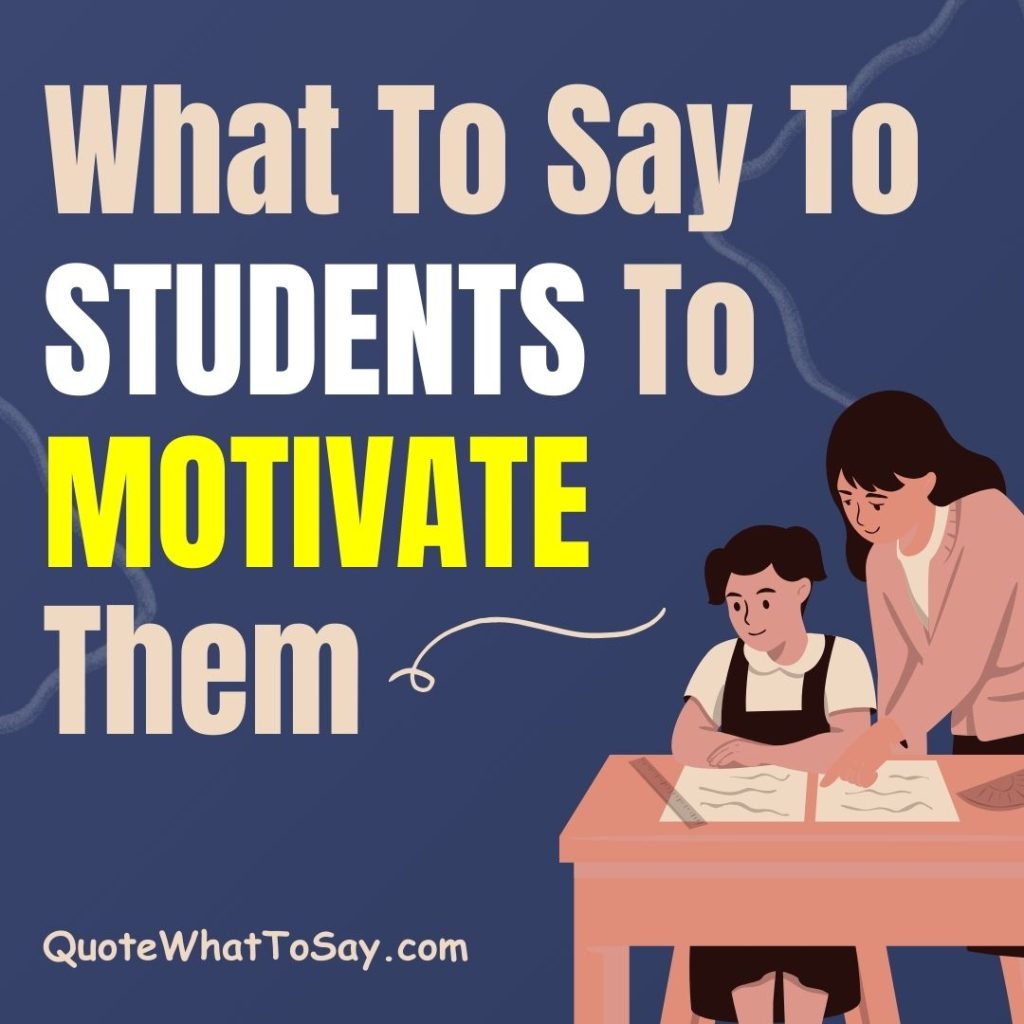Motivating students is a vital part of fostering a positive and productive learning environment.
The right words can inspire confidence, ignite curiosity, and encourage perseverance in the face of challenges.
When speaking to students, it is essential to focus on their potential, emphasize growth over perfection, and acknowledge their efforts.
By tailoring motivational messages to their individual needs, educators can help students see the value in their efforts and empower them to achieve their goals.

Encouraging Words for Students From Teachers
“Your persistence will pay off in the end.”
“You are capable of more than you think.”
“You’re not alone; I’m here to support you.”
“Trust yourself – you have the skills you need.”
“Think of every obstacle as a chance to grow.”
“This is just the beginning of your success story.”
“You’re investing in your future by learning today.”
“Every great accomplishment starts with small steps.”
“The more you challenge yourself, the more you grow.”
What To Say to Students to Motivate Them in School
“Every little win matters – celebrate it!”
“All that effort led to this success – well done!”
“You’re not just learning for today, but for life.”
“Learning is an adventure – enjoy the journey!”
“Your curiosity is the key to success in any field.”
“The journey is as important as the destination.”
“The ability to ask good questions will take you far.”
“Knowledge is something no one can take from you.”
“You’re building a foundation for your future success.”
Motivational Message for Students to Work Hard
“Your hard work is paying off!”
“Your effort is what matters most.”
“Patience and effort always lead to results.”
“The more you practice, the stronger you’ll get.”
“Keep pushing – you’ll be proud of yourself later.”
“Success comes from trying, even when it’s hard.”
“Keep looking for solutions – they’re always there.”
“The more you learn, the more doors open for you.”
Short Positive Messages For Students
“I believe in you.”
“Look how far you’ve come!”
“You earned this – great job!”
“Keep going – you’re on a roll!”
“You’re smarter than you think.”
“You’re getting better every day.”
“You’re capable of amazing things.”
“Your input is valuable to the team.”
“Believe in yourself – you’ve got this!”
“You bring something unique to the table.”
“You’re becoming an independent thinker.”
“You should be proud of what you’ve done.”
Positive Compliments for Students from Teachers
“You are a natural leader.”
“Your creativity is inspiring.”
“You are a great team player.”
“I admire how thoughtful you are.”
“You’re so good at staying focused.”
“Your determination inspires others.”
“You’ve achieved something amazing.”
“I can see how much you’ve improved!”
“You’re showing everyone what’s possible.”
“You have a great mind for problem-solving.”
“You have a unique way of looking at things.”
“Your curiosity is one of your greatest strengths.”
Short Encouraging Words for Students from Teachers
“Curiosity is the key to discovery.”
“Mistakes are just part of learning.”
“Focus on progress, not perfection.”
“Every struggle makes you stronger.”
“Setbacks are setups for comebacks.”
“Learning from failure is still learning!”
“Challenges are opportunities to grow.”
“The hard moments teach you the most.”
“You’ve got the courage to face any challenge.”
How To Encourage Students with Words
“You have the power to change your own story.”
“You’re learning how to bounce back – well done!”
“Learning takes time, and you’re making progress.”
“Confidence comes with practice, and you’re doing it!”
“Being adaptable is one of the best skills you can have.”
“Resilience is about getting back up – and you always do.”
“Learning is a superpower – you are unlocking it every day.”
“You’ve overcome tough things before, and you can do it again.”
“Learning how to think is more important than memorizing facts.”
Inspiring Quotes to Motivate Students to Study
“Genius is 10% inspiration, 90% perspiration.” – Thomas Edison
“There are no shortcuts to any place worth going.” – Beverly Stills
“The roots of education are bitter, but the fruit is sweet.” – Aristotle
“Learning is never done without errors and defeat.” – Vladimir Lenin
“Don’t watch the clock; do what it does. Keep going.” – Sam Levenson
“Teachers open the door, but you must enter by yourself.” – Chinese Proverb
“I find that the harder I work, the more luck I seem to have.” – Thomas Jefferson
“Motivation is what gets you started. Habit is what keeps you going.” – Jim Ryun
“There is no greater education than one that is self-driven.” – Neil deGrasse Tyson
“Develop a passion for learning. If you do, you will never cease to grow.” – Anthony J. D’Angelo
“The difference between a stumbling block and a stepping stone is how high you raise your foot.” – Benny Lewis
“Education is the passport to the future, for tomorrow belongs to those who prepare for it today.” – Malcolm X
“If people knew how hard I worked to get my mastery; it wouldn’t seem so wonderful at all.” – Michelangelo
“The more that you read, the more things you will know. The more that you learn, the more places you’ll go.” – Dr. Seuss
“He who asks a question is a fool for five minutes; he who does not ask a question remains a fool forever.” – Chinese proverb
“Obstacles can’t stop you. Problems can’t stop you. Most of all, other people can’t stop you. Only you can stop you.” – Jeffrey Gitomer
“Don’t say you don’t have enough time. You have exactly the same number of hours per day that were given to Helen Keller, Pasteur, Michelangelo, Mother Teresea, Leonardo da Vinci, Thomas Jefferson, and Albert Einstein.” – H. Jackson Brown Jr.
What To Say to Motivate High School Students
“Helping others helps you grow, too.”
“Every day is a chance to start fresh.”
“Every mistake is a step toward success.”
“Your attitude determines your altitude.”
“Positive thinking leads to positive results.”
“Every question you ask makes you smarter.”
“A good mindset is the foundation for success.”
“Communication is one of your strongest tools.”
“You’re building the skills to overcome challenges.”
What To Say to Encourage a College Student
“Quitting is the only way to fail.”
“Focus on what you can control.”
“You are more resilient than you realize.”
“Keep your eyes on the goal – it’s worth it.”
“You have the power to make a difference.”
“Failure is just feedback – it’s part of success.”
“Don’t give up – you’re closer than you think.”
“Stay curious – it’s the first step to innovation.”
“You’re stronger than any obstacle in your way.”
“Strength comes from facing challenges head-on.”
How to Motivate Students: Strategies for Inspiring Success
Motivating students is both an art and a science. It requires a combination of understanding their unique needs, creating a supportive environment, and employing effective strategies to foster a love for learning.
Inspiring students to reach their potential is a rewarding challenge – whether you are a teacher, parent, or mentor.
Here is an in-depth exploration of how to motivate students and help them thrive academically, socially, and emotionally.
Understanding Motivation: Intrinsic vs. Extrinsic
To motivate students effectively, it’s important to understand the two primary types of motivation:
- Intrinsic Motivation: This comes from within the student. It’s driven by curiosity, interest, or the desire to achieve personal goals. For example, a student might work hard because they enjoy the subject or find the challenge rewarding.
- Extrinsic Motivation: This arises from external factors, such as rewards, recognition, or avoiding negative consequences. For instance, a student might study hard to earn a good grade or win a prize.
While both types of motivation have their place, fostering intrinsic motivation is key to developing lifelong learners who are self-driven and resilient.
Creating a Positive Learning Environment
A supportive and engaging environment lays the foundation for student motivation. Here are several ways to build such an atmosphere:
- Show Genuine Care: Students are more likely to be motivated when they feel valued. Show interest in their lives, listen to their concerns, and acknowledge their efforts.
- Set High but Realistic Expectations: Challenge students to aim high while ensuring the goals are achievable. This balance promotes a growth mindset and prevents discouragement.
- Foster a Sense of Belonging: Create a classroom culture where every student feels included and respected. Encouraging collaboration and mutual respect builds a supportive community.
- Provide a Safe Space for Mistakes: Emphasize that mistakes are part of the learning process. When students feel safe to take risks without fear of judgment, they’re more likely to engage and persevere.
Building Intrinsic Motivation
Intrinsic motivation can be cultivated by tapping into students’ natural curiosity and desire for growth. Here are some strategies to achieve this:
- Connect Learning to Real-Life: Help students see the relevance of what they’re learning. For example, show how math applies to budgeting or how science explains everyday phenomena.
- Encourage Autonomy: Give students a sense of control over their learning by allowing them to choose projects, topics, or methods of completing tasks. Autonomy fosters ownership and engagement.
- Focus on Mastery, Not Grades: Shift the emphasis from grades to mastery of skills and concepts. Celebrate effort and progress rather than just the final outcome.
- Incorporate Students’ Interests: Tailor lessons to include topics that resonate with students. For instance, use sports statistics in math or popular culture in writing assignments.
- Promote Goal Setting: Help students set personal, achievable goals and break them into smaller steps. Reaching milestones boosts their confidence and motivation.
Leveraging Extrinsic Motivation
While intrinsic motivation is ideal, extrinsic motivation can provide a helpful boost, especially when students struggle to engage. Here is how to use it effectively:
- Offer Meaningful Rewards: Use rewards like praise, certificates, or privileges. Ensure they are meaningful to the students and tied to effort rather than innate ability.
- Use Positive Reinforcement: Acknowledge good behavior and hard work consistently. For example, saying “I’m proud of how hard you’ve worked” reinforces the value of effort.
- Create Healthy Competition: Friendly competitions, such as trivia games or contests, can motivate students to excel while promoting teamwork.
- Set Clear Expectations: Ensure students know what’s expected of them and the rewards for meeting those expectations. Clarity reduces anxiety and boosts confidence.
- Recognize Achievements Publicly: Highlight student successes in class, newsletters, or social media. Public recognition boosts morale and motivates others.
Encouraging Resilience and Perseverance
Resilience is a key component of motivation. Students who bounce back from setbacks are more likely to stay engaged and achieve their goals. Here is how to build resilience:
- Teach Growth Mindset: Help students understand that intelligence and abilities can be developed through effort. Use phrases like, “You haven’t mastered this yet,” to emphasize potential.
- Model Resilience: Share stories of your own challenges and how you overcame them. Seeing adults navigate difficulties inspires students to do the same.
- Break Tasks into Manageable Steps: Overwhelming tasks can discourage students. Simplify projects into smaller, achievable steps to build confidence.
- Celebrate Effort Over Perfection: Praise students for their perseverance and hard work, even if the result is not perfect. This reinforces the value of trying.
- Teach Problem-Solving Skills: Equip students with tools to tackle challenges, such as brainstorming solutions or seeking help when needed.
Using Technology to Boost Motivation
Incorporating technology into learning can make lessons more engaging and interactive. Here’s how:
- Gamify Learning: Use educational games and apps that reward progress and make learning fun. Platforms like Kahoot or Quizlet are great examples.
- Integrate Multimedia: Include videos, podcasts, and interactive simulations to make lessons dynamic and relatable.
- Provide Instant Feedback: Online tools often offer immediate feedback, helping students track their progress and stay motivated.
- Encourage Collaboration Through Tech: Use platforms like Google Workspace or Microsoft Teams to facilitate group projects and discussions.
- Personalize Learning Paths: Adaptive learning software can tailor content to individual student needs, keeping them challenged at the right level.
Building Strong Relationships
Strong relationships between students and educators are central to motivation. When students feel supported and understood, they’re more likely to engage. Here is how to build these connections:
- Get to Know Your Students: Learn about their interests, strengths, and challenges. Use this knowledge to personalize your interactions and lessons.
- Be Approachable: Create an open-door policy where students feel comfortable sharing their concerns or asking for help.
- Show Empathy: Acknowledge their feelings and struggles. Validating their experiences helps build trust and rapport.
- Be a Role Model: Demonstrate enthusiasm for learning and a positive attitude. Your behavior sets the tone for the classroom.
- Celebrate Diversity: Recognize and value the unique backgrounds and perspectives students bring. Inclusive practices foster a sense of belonging.
Overcoming Common Motivation Barriers
Students may face barriers that hinder their motivation. Here is how to address some common challenges:
- Lack of Confidence: Use affirmations and small successes to build self-esteem. Encourage students to focus on their strengths.
- Fear of Failure: Create a low-stakes environment where students can experiment and learn without fear of judgment.
- Disinterest in the Subject: Make lessons engaging by connecting them to real-world applications or incorporating creative activities.
- External Stressors: Be mindful of factors outside the classroom, such as family issues or peer pressure. Offer support and flexibility when needed.
- Procrastination: Teach time management skills and help students break tasks into smaller, actionable steps.
Key Takeaways: Motivating Students for Success
Motivating students is a dynamic process that requires empathy, creativity, and persistence.
By fostering a positive learning environment, leveraging intrinsic and extrinsic motivators, and building resilience, educators and mentors can inspire students to achieve their potential.
Remember, every student is unique, and what works for one may not work for another. The key is to remain patient, adaptable, and committed to their growth.
When students are motivated, they not only excel academically but also develop the confidence and skills needed to navigate life’s challenges with determination and purpose.




